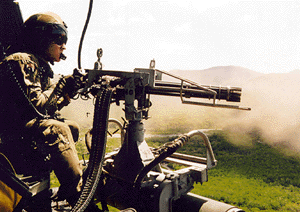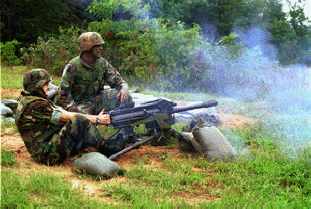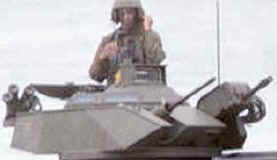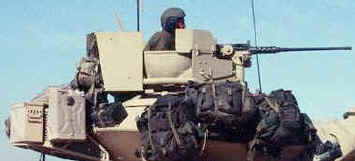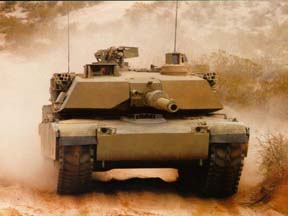
The US Army has wasted billions of dollars to upgrade a few hundred tanks to the M1A2 configuration (right), and wants to spend billions to convert more. The US Army claims that no tanks were lost to enemy fire during the Persian Gulf war, so why upgrade their anti-tank capabilities with a few gadgets which cost twice as much as the tanks themselves? Tanks remain vital, but the US Army spends half of its operations and maintenance budget for all ground equipment to keep 5000 M1 series tanks ready for World War III with the Soviets.
There is much debate about the future organization of US Army combat forces, but no sane soldier believes a heavy division needs over 300 heavy M1 tanks. The Army should cut that number in half to make these divisions more mobile. The Army should scrap 3000 of these excess tanks to produce a 10-year supply of spare tank parts and engines, and upgrade the remainder as M1A3s to make them better people killers.
An outstanding book on the employment of armor against light infantry is Mounted Combat in Vietnam, which was produced as part of the US Army's Vietnam Studies series. If the Army would have paid attention to its own lessons learned books, it would have sent a mechanized infantry brigade to Somalia rather than a light infantry brigade. After the Ranger fiasco, tanks were sent to Somalia and convoys escorted by tanks were never attacked. As a result, the US Army sent tanks for peacekeeping duty in Bosnia, and they were decisive intimidators in several confrontations.
Unfortunately, Abrams tanks are poorly equipped to combat infantry. The Army needs to immediately procure 120mm canister "beehive" rounds and 120mm Improved Conventional Munition "bomblet" rounds. These rounds should have reduced propellant charges so they can be fired near friendly infantrymen. Current 120mm rounds produce so much force that infantrymen in front of the tank or within 50 meters to the side can be injured by the gun blast. A long-range laser-guided round (like the Israeli LAHAT) is also needed, perhaps modified 120mm Hellfire missiles.
The Abrams also needs improved secondary armaments. The tank gunner has sights which allows him to engage targets at over 3000 meters. However, his 7.62mm coaxial machine gun only reaches out 1100 meters, so it should be upgraded to a .50 caliber (12.7mm) machine gun which can reach out over 2000 meters with far greater power. In addition, the loader’s basic M240C 7.62mm machine gun should be replaced with a M134 7.62mm mini-gun, which can fire ten times faster and pulverize nearby infantry. Finally, the tank commander also needs a better weapon to engage infantry, so replace his M2 .50 cal machine gun with the Mk-19 40mm automatic grenade launcher. Since these weapons provide far more firepower, they consume more ammunition. As a result, large steel ammo boxes would be added to the top of the turret.
The 7.62mm mini-gun and the 40mm auto grenade launcher
These external gun mounts also need shields. When the M-113 Armored Personnel Carrier made its debut in Vietnam at the battle of Ap Bac, the .50 cal heavy machine gun mounted atop the M-113 had no armored shields. Anyone who rose out of the top hatch to employ the weapon became the primary target for enemy infantrymen and was quickly gunned down. The Army soon mounted gun shields to correct the problem, seen today on many M113A3 models.
The amtrack turret or Sheridan gun shields are good options
One option is the small turret now used on Marine Corps amtracks which mount both a .50cal and 40mm gun. The M551Sheridan light tank used gunshields to form a "crow's nest", while the M-48 and M-60 tanks have large armored cupolas. However, the M1 Abrams has nothing, probably because its designers wanted a clean/mean look. The machine gun can be fired remotely from inside the tank, but visibility is poor, it may jam, and tank commanders have a fatal habit of riding in their open hatch anyway. The Abram tanks need armored shields on the tank commanders' and loaders’ gun mounts, perhaps shields from scrapped tanks could be used.


M-60 tanks had cupolas, but M1 tank crews are totally exposed
There are low cost elements of the M1A2 program which should be adopted. GPS systems cost as little as $100 on the commercial market, and even the top-line military versions cost only $5000. An independent thermal viewer for the tank commander is a good idea, but it should cost no more than $10,000. Finally, a small external electric generator is essential, which cost less than $1000 on the commercial market. This allows the tank to shut off its gas guzzling engine while in defensive or overwatch positions. All of these upgrades should cost less than $100,000 per tank, and the Army could designate these infantry killer tanks as M1A3s. This would allow the Army to upgrade thousands of tanks to M1A3s at a lower cost than the M1A2 fiasco in which the Army paid $6 million dollars for minor upgrades to each $3 million dollar M1 tank.
A final improvement is to replace the gas guzzling gas turbine engine with an economical diesel, and add a tank roof; ideas described in other G2mil articles. Follow this link for an excellent overview of the M1 tank program.
Carlton Meyer editorG2mil@Gmail.com
Update
A year after this article appeared, the US Army began to purchase canister munitions, something I had recommended directly to the Marine Corps back in 1993. The Marines looked into it and wanted some, but determined it would be too expensive unless the Army joined in production, which it refused.
XM1028 120mm Canister Tank Cartridge
The Tank Cartridge, 120mm, Canister, XM1028, is a tank round comprised of 1150 (est.) tungsten balls, which are expelled upon muzzle exit. There is no fuse on this round. While the dispersion pattern increases with range as the velocity of the balls decreases, the dense tungsten balls are used to minimize the velocity fall-off. This program responds to the USFK urgency of need signed by the CINC in Dec ‘99. RAPT Initiative Funding to be used for 6.0M in FY02 to accelerate development by one year earlier than previously planned.
This round meets urgent CINC, USFK requirements to provide effective rapid lethal reaction against massed assaulting infantry armed with hand held anti-tank and automatic weapons at close range (500 meters or less) thereby improving survivability. Additionally, this round will significantly increase the tank’s lethality and enhance the tank crew’s survivability. This additional capability will give the Abrams Tank the ability to survive RPG ambushes and to fully support friendly infantry assaults.

Tanks take a beating in Iraq - not designed for insurgent attacks
Tanks adapted for urban fights - needed in cities despite vulnerabilities
NOTES
___________________________________________
"Iron Soldiers" is a good Gulf war book, written by tankers from the 1st Mech Division. They disclosed that Soviet-made 125mm guns were unable to penetrate the M1A1 frontal armor, even a close ranges. Their tungsten penetrators stuck into the armor like arrows. However, a T-62 took out two M1A1s at night with flank shots. This Iraqi understood infra-red sensors, so his crew stayed inside their tanks and left the engines off. They used the back-up hand turret crank to aim their gun and blew away two M1A1s at close range before they were hit after their hot gun barrel exposed them.
Iraqis who ran their engines to keep warm and power their turret where destroyed at long ranges. Others left their engines off, but stood on top of their tanks to find targets. US tankers thermal systems were so good they could pick up Iraqis "floating" off the ground, and simply fired at their feet. If all the Iraqi tankers sat "cold" at night, VII Corps would have been bloodied in some battles.
Letters
Some countries field tanks with a light
cannon in addition to a 7.62mm machine gun as a coaxial weapon. A 50 caliber MG
will be easier to retro-fit and should be nearly as effective, giving the gunner
cost effective capability against light armour to at least 2000m. The Israelis
use .50 BHMGs mounted above the main gun and these are used for both combat and
training.
Main Gun improvements. Many years ago Jane's Defence Yearbook
compared the Rheinmental smooth bore and Royal Ordinance rifled 120mm guns. It
concluded that the rifled gun was the better weapon since it was more versatile.
American and German operational experience has confirmed this. One of the
reasons that the British gun is more versatile is that it has a HESH round. As
well as being an effective anti-tank round it is also a potent demolition round
and eliminates the need for a separate HE round. It is unlikely that the Abrams
will switch to the Royal Ordinance but it should be possible to issue a fin or
drag stabilised HESH round. Other rounds that may prove useful are Canister, WP,
Thermobaric and Flame-capsule.
Loader's position. I've suggested Mk-19 GMGs mounted above the
main gun for other vehicle types, but for a system such as the Abrams that has a
human loader it makes more sense to mount this weapon on the loader's hatch.
This allows the most suitable belt of ammunition to be loaded to suit the
tactical situation. Possible loads include HE/HEDP, smoke, flare and chaff
decoys or flechette rounds.
Commander's position. The commander's firing position may retain
the BHMG, probably with a mantellet so the commander can operate "heads
up". The capabilities of BHMG tend to complement those of the loader's
Mk-19.
Gun Shields: Some Israeli tanks have a commander's hatch that can be lifted straight
up like a manhole cover. A transparent armored screen could be fitted beneath
this. This would be opaque to infra-red so the commander can operate heads up
and enjoy good visibility while not giving away the tank's position to thermal
imagers.
Phil West phil.west@angelfire.com
Great article. I have liked the
idea of the Mk19 on the M1 for a while. As for the beehive round, that's
currently in development, as is a laser guided munition. Also, bring back
HEP ammo. Like the idea of the .50 cal coax, though ammo storage would be
a problem (but do we really need 14,400 rounds of coax?) and a counter weight
would have to added to the gun barrel, but its doable. I like the idea of
slaving the commander's weapon to the CITV, though I still like the .50 Cal.
Some other additions that could be added for low intensity are grenade launchers
mounted on the loader's hatch that can be fired internally like that can be
fitted to the Leo and a camera placed on the rear of the tank so the driver can
back up from his station without the TC having to unbutton. As for the
turbine, you know my position (and a vast majority of the users of this tank) is
to get a new turbine, not a noxious, loud, unresponsive diesel.
Maybe what is needed is not a retrofitted M1, but
another type of tank all together. It is obvious that the M1 series was
NOT designed to support infantry, but for the infantry to support the tank.
I believe that if the US Army attempts to modify the Abrams to fit the urban
combat mission, it will turn out like the Bradley and become pretty much
worthless in any mission. What is needed is to upgrade the M60A3 tank
(which incorporates already many of the upgrades your want) for use in urban
conflict fighting. The US Army is working under McNamarians concepts of
one vehicle, multiple missions instead of one vehicle, one mission. The
Abrams is unparalleled in its current mission, that of tank killer. Why
try to make it something it isn't? Add a Bradley A3 CIV to an M60A3, put
in a .50 cal coax (there's more than enough room on the 60, unlike the M1) and a
Mk19 in the commander's cupola, put on Blazer Armor, add an overpressurized NBC
system, rear mounted camera and loader's hatch grenade launcher and you have the
perfect tank for urban warfare. It carries 63 105mm rounds and the design
for beehive, HE and HEP are already out there so they don't have to be
developed, it has an escape hatch in the floor, a dismount phone without a
turbine, heavy armor and ballistic fire computer, LRF and thermals. It is
relatively slow and can still use it's turret with infantry mounted on top.
It is unlikely it will get into a tank on tank engagement in the city, so it
would only have to carry a few SABOT, so the rest can be used to make new dorrs
into buildings. Why mess with a tank that is outstanding in its current
mission when it isn't needed. Add FBCBC2 so you don't to use radios.
As for the other suggestions for the M1A3, the M1A2 SEP already incorporates the
suggestions given. Internal GPS, upgraded armor package, POSNAV system,
CITV, UAAPU (Under-Armor Auxillary Power Unit), FLIR2 (not TIS) and TMS (Thermal
Management System). The GPS is mounted on the CITV shield and in hooked
directly into the FBCB2 system. It gives GPS time for the radios and
position for the FBCB2 map. The upgraded armor incorporates a DU layer
along with an upgraded Cholbam Armor mix. The CITV (though nowhere near
10,000 dollars; nearer to 350,000) is mounted where the old turret blower
assembly was on the M1A1 HC. The Under Armor Auxillary Power Unit is a
small turbine mounted in the back deck. It is produced by Royles-Royce and
uses 3-5 gallons per hour. It provides enough power to run the turret
hydralics at full power so the auxillary pump does not have to be used (the tank
can actually engage with just the APU) and it is much more quiet than the
busselrack mounted APUs on the M1A1/M1A2s. The FLIR2 does not use heat but
light and can positively ID targets at +5,000m. Actually, a completely
cold target (such as unheated panels on a gunnery range) through the FLIR2
sticks out almost as much as a running tank. Heck, during our last TTVIII,
the mover was completely cold and the tower couldn't see it through their TIS,
though we could easily see it through the tank sights and shoot it. The
Thermal Management System on the SEP keeps the turret at a cool 85-90
degrees, not to improve crew efficiency, but to keep the electronics cool.
The temperature inside the SEP turret, with all computer components running, cn
get up to 120 degrees on a 90 degree day (and imagine that in MOPP4!). The
SEP was recently proven against the OPFOR at NTC during NTC 01-06 (DCX) where,
in continuous ops, the BLUEFOR maintained an OR rating of 90% (couldn't LD with
less that 90%) and went 6 for six in "battle". All missions were
done at night with 5 out of 6 being offensive operations. During live
fire, the SEP made continuous 4,000m+ kills with training ammunition that is far
less accurate at range than service ammunition. It is a hell of a tank,
but is relatively useless in city fighting. Why degrade its "tank
killing" ability for a new mission when an older style tank could do the
same mission more effectively and cost much less?
ANDREW WILBRAHAM
1LT, AR Platoon Leader
2/B/1-67 Armor "DEATH DEALERS!"
I found this 2001 article in "Armor" magazine which recommends many of your M1A3 ideas: Modifying the Abrams Tank For Fighting in Urban Areas.
Phil West
